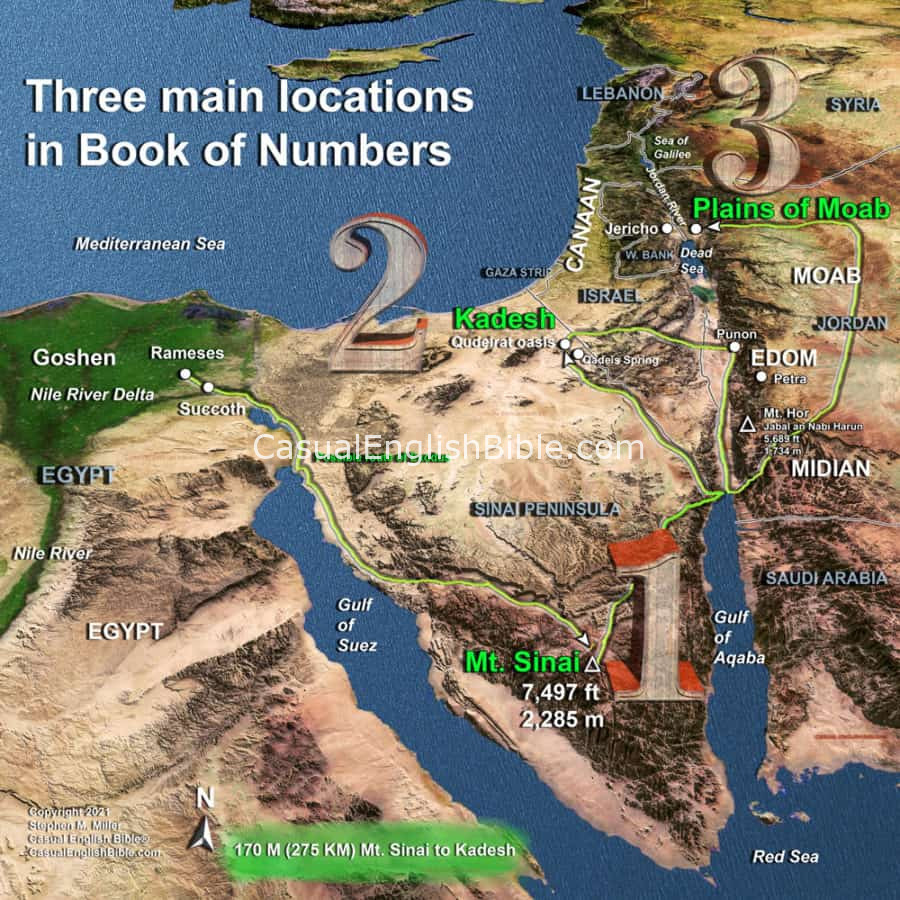This should have been the story of Moses leading the Israelite invasion into Canaan.
But Moses never steps foot in Canaan. The entire generation of adults age 20 and above misses the invasion, too. Joshua and Caleb are the only exceptions, because of their confidence in God.
The plan was to march north out of the Sinai Peninsula and overrun Canaan’s cities in the southland first. But the Israelites choke. Scouts come back with a report that terrifies them. The enemy has walled cities, strong armies, and giants.
“Looking up at them, we felt like grasshoppers. And looking down at us, they felt we looked like grasshoppers, too” (Numbers 13:33).
Israelites refuse to attack. For that vote of zero confidence, God, who has already shown them his power in ways as dramatic as the 10 plagues of Egypt, sentences them to 40 years in the desert badlands.
Afterward, an elderly Moses, soon to die, leads the next generation to the east bank of the Jordan River. It’s the staging ground for the invasion that Moses won’t live to see.
Enroute to the river, Israelites respond to attacks from several armies by defeating them and taking their land. Two tribes of Israel decide to settle there, in what is now Jordan. But they also agree to join the invasion.
The story of Numbers starts with Moses taking a census, apparently to see what kind of an army God has to work with. That’s where the book gets its name, Numbers. The ancient Hebrew name, however, is Bemidbar, “in the wilderness.”
Writer
There’s no byline. We don’t know who wrote Numbers. Ancient Jewish tradition says Moses wrote the Bible’s first five books, from Genesis to Deuteronomy, under the direction of God. “God had the angel of his presence [possibly a way of referring to God himself] tell Moses the story of creation…until the time God will build an eternal temple for his people” (Jubilees 1:26, Dead Sea Scrolls).
One clue Moses may not have written all of it: “Moses was a humble man. The humblest man on earth” (Numbers 12:3). If he wrote that, he had chutzpah, and maybe a personality disorder.
Many scholars, perhaps most, say Numbers was likely pieced together from several sources. They say one source seems to come from priests, who wrote about sacrifices and worship rituals. Other sources are storytellers reporting tales such as one about a seer named Balaam, who had a temporarily talking donkey.
Timeline
Scholars usually date these events to sometime between the 1400s-1200s BC. Stories in the Book of Numbers span a generation. “You’re going to die in the badlands. While you wait to die, your children will spend the next 40 years as herders in the badlands—suffering the consequences of your sins” (Numbers 14:32-33). Numbers is the story of what happens just before, during, and shortly after that 40-year stretch.
Location
There are three main locations in this part of Israel’s story.
- Sinai. Israelites are camped at the foot of Mount Sinai, the location of which is uncertain today. But it seems somewhere in the Sinai Peninsula.
- Desert. They spend a generation living as wandering herders in the Sinai and as far north as the border of Israel. They spend perhaps much of that time near an oasis called Kadesh, which most scholars say was along the Egypt-Israeli border, on Egypt’s side.
- Jordan River. On the move again toward the Promised Land in what is now Israel and Palestinian territories, they camp near the east side of the Jordan River, across from Canaan’s border town of Jericho. That puts them in the plains of Moab, in what is now the country of Jordan.
Purpose
Numbers is part of the story of how the descendants of Jacob—renamed “Israel” by God—put his name on the map as the nation of Israel.
Numbers continues the saga that started in Exodus, with Moses freeing the Israelites from slavery and beginning to lead them back to their ancestral home of Canaan. That’s in what is now Israel and Palestinian territories.
They take the scenic route through the desert badlands, perhaps to bypass Egyptian forts and outposts along the shorter coastal route. They camp for about a year at the foot of Mt. Sinai, where Moses first met God at the famous burning bush. There, Moses gets many of the laws that still govern observant Jews today. Leviticus preserves many of those laws, too.
Numbers tells the story of what happens next. The planned invasion becomes a slow-motion, 40-year meandering journey, dodging enemies when possible. After a generation in the desert, Israelites walk and, when necessary, fight their way from the Sinai to the plains of Moab. That’s just across the Jordan River from their first target in Canaan: the city of Jericho.
The story of the birth of Israel will continue in Deuteronomy with Moses saying goodbye. He will remind the Israelites of the laws they need to honor, and of what will happen to them if they don’t honor them. In time, centuries later, the worst that Moses predicts will happen. Jews will worship idols and Israel will fall.




